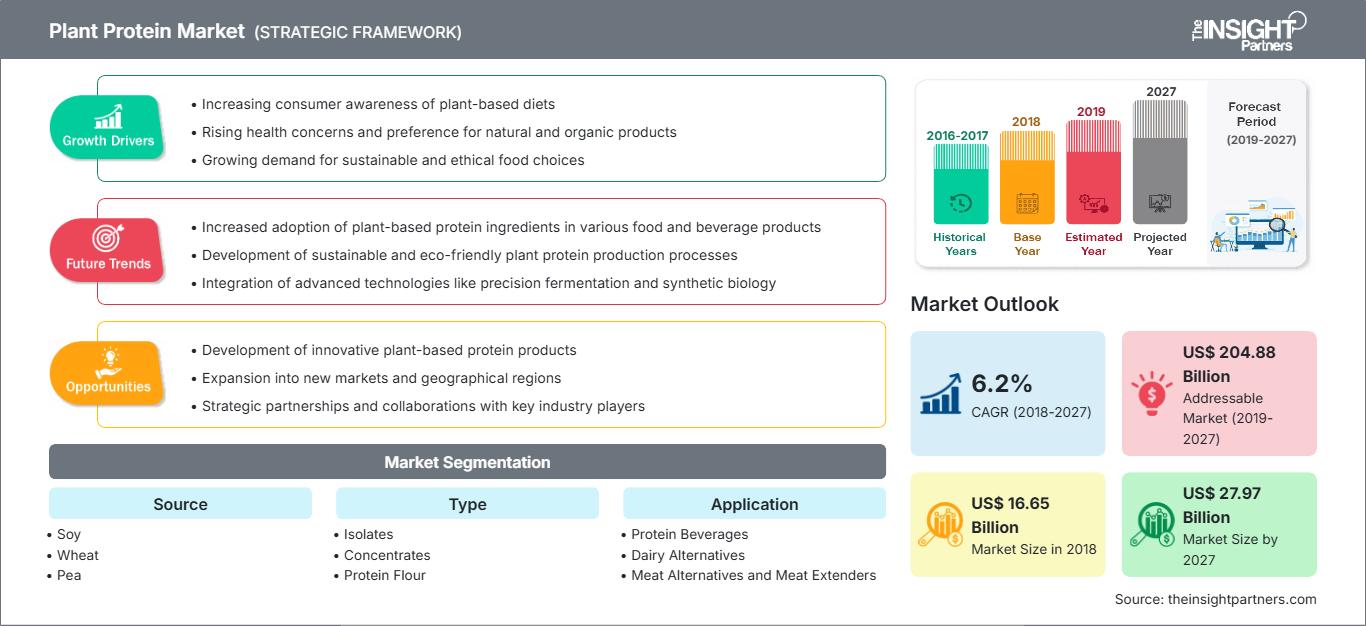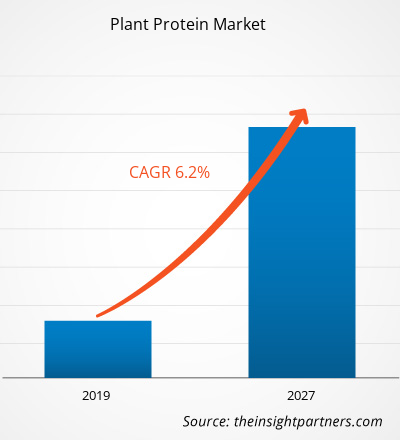Der Markt für pflanzliche Proteine wurde 2018 auf 16.653,6 Millionen US-Dollar geschätzt und soll bis 2027 voraussichtlich 27.965,9 Millionen US-Dollar erreichen; von 2019 bis 2027 wird ein durchschnittliches jährliches Wachstum von 6,2 % erwartet.
Proteine sind lebenswichtige Nährstoffe, die der menschliche Körper benötigt und die aus Aminosäuren bestehen. Pflanzliche Proteine werden aus verschiedenen pflanzlichen Quellen wie Soja, Weizen, Erbsen, Nüssen und Samen gewonnen. Verschiedene pflanzliche Quellen wie Linsen, Kichererbsen, Erdnüsse, Mandeln, Spirulina, Quinoa und Chiasamen liefern einen hohen Proteingehalt. Da pflanzliche Proteine kalorienarm sind, können sie zur Gewichtsabnahme als Ersatz für tierisches Eiweiß konsumiert werden. Die wachsende Nachfrage nach pflanzlichen Lebensmitteln in Verbindung mit dem steigenden Interesse der Verbraucher an proteinreichen Lebensmitteln sind die Hauptfaktoren, die das Wachstum des Marktes für pflanzliche Proteine weltweit ankurbeln.
Der Markt für pflanzliche Proteine in der Region Asien-Pazifik wird im Prognosezeitraum voraussichtlich die höchste durchschnittliche jährliche Wachstumsrate (CAGR) aufweisen. Das Wachstum des Marktes für pflanzliche Proteine in dieser Region ist hauptsächlich auf den Anstieg des verfügbaren Einkommens zurückzuführen, wobei sich die Lebensstile ändern. Dies sind die wichtigsten treibenden Faktoren für pflanzliche Proteine in der Region Asien-Pazifik. Das schnelle Wachstum der Lebensmittel- und Getränkeindustrie in den entwickelten und sich entwickelnden asiatischen Ländern wie China, Indien und Japan bietet Herstellern pflanzlicher Proteine enorme Marktchancen, da diese in großem Umfang in Produkten wie Proteingetränken, Milchalternativen, Fleischalternativen und Proteinriegeln verwendet werden.
Das steigende verfügbare Einkommen der Menschen in entwickelten und sich entwickelnden Ländern wie Indien, China und Australien hat zu einer enormen Nachfrage nach pflanzlichen Proteinen in dieser Region geführt.
Passen Sie diesen Bericht Ihren Anforderungen an
Sie erhalten kostenlos Anpassungen an jedem Bericht, einschließlich Teilen dieses Berichts oder einer Analyse auf Länderebene, eines Excel-Datenpakets sowie tolle Angebote und Rabatte für Start-ups und Universitäten.
Markt für Pflanzenproteine: Strategische Einblicke

-
Holen Sie sich die wichtigsten Markttrends aus diesem Bericht.Dieses KOSTENLOSE Beispiel umfasst Datenanalysen, die von Markttrends bis hin zu Schätzungen und Prognosen reichen.
Markteinblicke: Steigendes Verbraucherbewusstsein für proteinreiche Lebensmittel fördert Wachstum des Marktes für pflanzliche Proteine
Proteine spielen eine Schlüsselrolle beim Transport von Molekülen durch den Körper, indem sie die Zellreparatur unterstützen und den Körper vor Viren und Bakterien schützen. Sie fördern außerdem das richtige Wachstum und die Entwicklung bei Kindern, Jugendlichen und Schwangeren.
Verschiedene Studien zeigen, dass eine proteinreiche Ernährung den Aufbau von Muskelmasse und Kraft fördert und Muskelabbau während der Gewichtskontrolle oder eines Abnehmprogramms vorbeugt.
Menschen, die mehr Protein zu sich nehmen, erhalten tendenziell ihre Knochenmasse besser und haben ein deutlich geringeres Risiko für Osteoporose und Knochenbrüche. Eine hohe Proteinzufuhr hat einen angekurbelten Stoffwechsel zur Folge, wodurch viele Kalorien verbrannt werden. Dies trägt zusätzlich zur Gewichtskontrolle und Gewichtsabnahme bei. Diese Vorteile von Proteinen ziehen Verbraucher zu proteinreichen Lebensmitteln und Getränken auf dem Markt. Dies führt weltweit zu einer enormen Nachfrage nach pflanzlichen Proteinen.
Proteinreiche Lebensmittel gelten als einer der stärksten Trends in der Lebensmittel- und Getränkeindustrie. Dem Proteintrend in der Lebensmittelindustrie folgend, versuchen Lebensmittel- und Getränkehersteller, nahrhafte Lebensmittelprodukte herzustellen. Das steigende Bewusstsein der Verbraucher für effektive Möglichkeiten zur Gewichtsabnahme, Anti-Aging und zur Behandlung anderer gesundheitlicher Probleme durch den Verzehr proteinreicher Lebensmittel treibt die Nachfrage nach pflanzlichen Proteinen an. Zudem haben wachsende Gesundheits- und Wellnesstrends in den letzten Jahren eine starke Nachfrage nach funktionellen und angereicherten Lebensmitteln und Getränken geschaffen. Daher wird erwartet, dass das steigende Verbraucherbewusstsein für proteinreiche Lebensmittel das Wachstum des Marktes für pflanzliche Proteine ankurbelt.
Quellenbasierte Erkenntnisse
Basierend auf der Quelle wird der Markt für pflanzliche Proteine in Soja, Weizen, Erbsen und andere unterteilt. Das Sojasegment hatte 2018 den größten Marktanteil; das Erbsensegment wird im Prognosezeitraum jedoch voraussichtlich die höchste durchschnittliche jährliche Wachstumsrate (CAGR) des Marktes verzeichnen. Sojaproteinisolat ist eine hochraffinierte Form von Sojaprotein mit einem Proteingehalt von mindestens 90 %. Es wird aus entfettetem Sojamehl hergestellt, aus dem die meisten nicht-proteinhaltigen Bestandteile, einschließlich Fette und Kohlenhydrate, entfernt wurden. Sojaproteinpulver wird aus entfetteten Sojabohnenflocken hergestellt, die in Alkohol oder Wasser gewaschen werden, um Zucker und Ballaststoffe zu entfernen. Anschließend werden sie dehydriert und zu Pulver gemahlen. Sojaproteinpulver wird zur Herstellung von Soja-Säuglingsnahrung sowie einer Vielzahl von Fleisch- und Milchalternativen verwendet. Sojaproteinkonzentrate enthalten typischerweise 70 % Sojaprotein und sind im Grunde entfettetes Sojamehl ohne wasserlösliche Kohlenhydrate. Diese Proteinform wird hergestellt, indem ein Teil der Kohlenhydrate aus geschälten und entfetteten Sojabohnen entfernt wird. Sojamehl wird hergestellt, indem Sojabohnen zu einem feinen Pulver gemahlen werden.
Typbasierte Erkenntnisse
Basierend auf dem Typ ist der Markt für Pflanzenproteine in Isolate, Konzentrate und Proteinmehl unterteilt. Das Segment der Konzentrate hatte 2018 den größten Marktanteil. Pflanzenproteinkonzentrate werden durch Extraktion von Protein aus verschiedenen Quellen wie Soja, Weizen, Erbsen, Quinoa, Hafer, Bohnen und Nüssen hergestellt. Sie enthalten typischerweise 60–80 % Protein, die restlichen 20–40 % bestehen aus Fett und Kohlenhydraten. Konzentriertes Pflanzenprotein ist die am wenigsten verarbeitete Art von Proteinpulver. Pflanzenprotein in konzentrierter Form hilft den Muskeln, sich schnell von schweren Übungen zu erholen, da es schnell vom Körper aufgenommen wird. Daher sind die leichte Verfügbarkeit von Pflanzenproteinkonzentraten und die niedrigeren Preise im Vergleich zu Pflanzenproteinisolaten die wichtigsten Faktoren, die den Markt ankurbeln. Pflanzenproteinkonzentrate sind tendenziell die günstigste Option, bieten aber im Vergleich zu Pflanzenproteinisolaten die geringste Proteinmenge, da sie mehr andere Inhaltsstoffe enthalten. Diese zusätzlichen Inhaltsstoffe können Fett, Cholesterin, Laktose und Gluten sein. Verbraucher, die ihre Fettaufnahme begrenzen möchten oder eine empfindliche Verdauung haben, sollten pflanzliche Proteinkonzentrate meiden.
Anwendungsbasierte Erkenntnisse
Der Markt für pflanzliche Proteine ist nach Typ in Proteingetränke, Milchalternativen, Fleischalternativen und Fleischverbesserer, Proteinriegel, Backwaren und andere Anwendungen unterteilt. Das Segment Fleischalternativen und Fleischverbesserer hatte 2018 den größten Marktanteil. Zu den Fleischalternativen gehören unter anderem Tofu, Tempeh, texturiertes Pflanzenprotein, Seitan und Quorn. Diese Produkte ähneln in Geschmack, Aussehen und Textur Geflügel-, Fleisch- und Fischprodukten. Sie werden aus getreide- und pflanzenbasierten Zutaten hergestellt, um tierische Proteine und Mineralien (insbesondere Kalzium) zu ersetzen. Dies hilft, den Cholesterinspiegel zu senken und Wechseljahrsbeschwerden und anderen damit verbundenen Beschwerden vorzubeugen. Pflanzliche Proteine werden in großem Umfang zur Herstellung von Fleischalternativen verwendet. Bohnen und Hülsenfrüchte sind erschwingliche Quellen für pflanzliches Protein, das als Fleischersatz dient. Soja ist auch eine der wichtigsten Quellen für die Herstellung von Fleischalternativen. Erbsenproteinisolate werden hauptsächlich von Herstellern von Fleischalternativen wie Daiya, Gardein, Ben & Jerry's, Beyond Meat, Just Mayo und Ripple Foods verwendet. Daher führt der Anstieg der Nachfrage und Produktion von Fleischalternativen zu einer höheren Nachfrage nach pflanzlichen Proteinen. Die Nachfrage nach Fleischalternativen steigt aufgrund wachsender Gesundheitsbedenken der Verbraucher und der zunehmenden Vorliebe für vegane Lebensmittel. Darüber hinaus hat die steigende Fettleibigkeit aufgrund des Konsums von Fleisch und Fleischprodukten zu einer zunehmenden Vorliebe der Verbraucher für Fleischersatz geführt.
Einige Akteure auf dem Markt für pflanzliche Proteine sind Archer Daniels Midland Company; Axiom Foods, Inc.; Burcon NutraScience Corporation; Cargill, Incorporated; EI Du Pont De Nemours and Company; Glanbia plc; Ingredion Incorporated; Kerry Group; Koninklijke DSM NV; und Roquette Frères. Die wichtigsten Unternehmen setzen Fusionen und Übernahmen sowie Forschungs- und Entwicklungsstrategien um, um ihren Kundenstamm zu erweitern und bedeutende Marktanteile auf dem Weltmarkt zu gewinnen, was ihnen auch ermöglicht, ihren Markennamen weltweit zu behaupten.
Markt für Pflanzenproteine
Die Analysten von The Insight Partners haben die regionalen Trends und Faktoren, die den Markt für Pflanzenproteine im Prognosezeitraum beeinflussen, ausführlich erläutert. In diesem Abschnitt werden auch die Marktsegmente und die geografische Lage in Nordamerika, Europa, dem asiatisch-pazifischen Raum, dem Nahen Osten und Afrika sowie Süd- und Mittelamerika erörtert.Umfang des Marktberichts zu pflanzlichen Proteinen
| Berichtsattribut | Einzelheiten |
|---|---|
| Marktgröße in 2018 | US$ 16.65 Billion |
| Marktgröße nach 2027 | US$ 27.97 Billion |
| Globale CAGR (2018 - 2027) | 6.2% |
| Historische Daten | 2016-2017 |
| Prognosezeitraum | 2019-2027 |
| Abgedeckte Segmente |
By Quelle
|
| Abgedeckte Regionen und Länder |
Nordamerika
|
| Marktführer und wichtige Unternehmensprofile |
|
Dichte der Marktteilnehmer für pflanzliche Proteine: Verständnis ihrer Auswirkungen auf die Geschäftsdynamik
Der Markt für pflanzliche Proteine wächst rasant. Die steigende Nachfrage der Endverbraucher ist auf Faktoren wie veränderte Verbraucherpräferenzen, technologische Fortschritte und ein stärkeres Bewusstsein für die Produktvorteile zurückzuführen. Mit der steigenden Nachfrage erweitern Unternehmen ihr Angebot, entwickeln Innovationen, um den Bedürfnissen der Verbraucher gerecht zu werden, und nutzen neue Trends, was das Marktwachstum weiter ankurbelt.

- Holen Sie sich die Markt für Pflanzenproteine Übersicht der wichtigsten Akteure
Bericht-Spotlights
- Fortschreitende Branchentrends im Pflanzenproteinmarkt, um Akteuren bei der Entwicklung effektiver langfristiger Strategien zu helfen
- Geschäftswachstumsstrategien in entwickelten und sich entwickelnden Märkten
- Quantitative Analyse des Pflanzenproteinmarktes von 2018 bis 2027
- Schätzung der weltweiten Nachfrage nach Pflanzenprotein
- PEST-Analyse zur Veranschaulichung der Wirksamkeit von Käufern und Lieferanten in der Branche
- Jüngste Entwicklungen zum Verständnis des Wettbewerbsmarktszenarios
- Markttrends und -aussichten sowie Faktoren, die das Wachstum des Pflanzenproteinmarktes vorantreiben und hemmen
- Unterstützung im Entscheidungsprozess durch Hervorhebung von Marktstrategien, die das kommerzielle Interesse untermauern und zum Marktwachstum führen
- Die Größe des Pflanzenproteinmarktes an verschiedenen Knotenpunkten
- Detaillierte Übersicht und Segmentierung des Marktes sowie die Dynamik der Pflanzenproteinbranche
- Größe von der Markt für Pflanzenproteine in verschiedenen Regionen mit vielversprechenden Wachstumschancen
- Historische Analyse (2 Jahre), Basisjahr, Prognose (7 Jahre) mit CAGR
- PEST- und SWOT-Analyse
- Marktgröße Wert/Volumen – Global, Regional, Land
- Branchen- und Wettbewerbslandschaft
- Excel-Datensatz
Aktuelle Berichte
Erfahrungsberichte
Grund zum Kauf
- Fundierte Entscheidungsfindung
- Marktdynamik verstehen
- Wettbewerbsanalyse
- Kundeneinblicke
- Marktprognosen
- Risikominimierung
- Strategische Planung
- Investitionsbegründung
- Identifizierung neuer Märkte
- Verbesserung von Marketingstrategien
- Steigerung der Betriebseffizienz
- Anpassung an regulatorische Trends






















 Kostenlose Probe anfordern für - Markt für Pflanzenproteine
Kostenlose Probe anfordern für - Markt für Pflanzenproteine